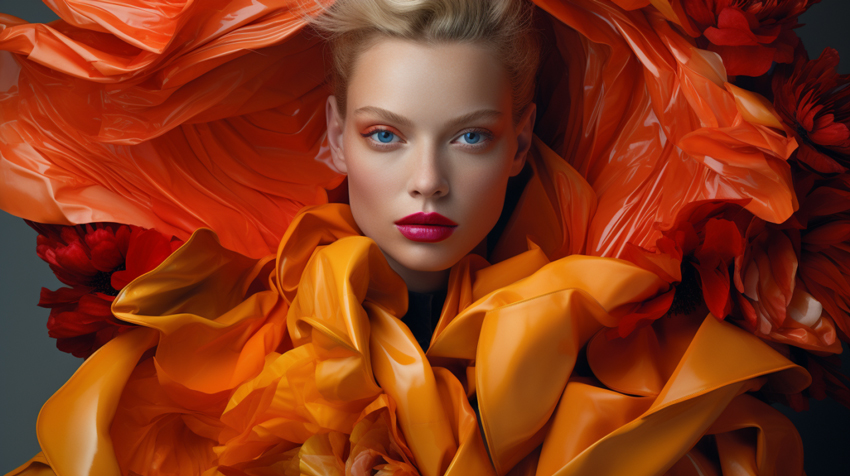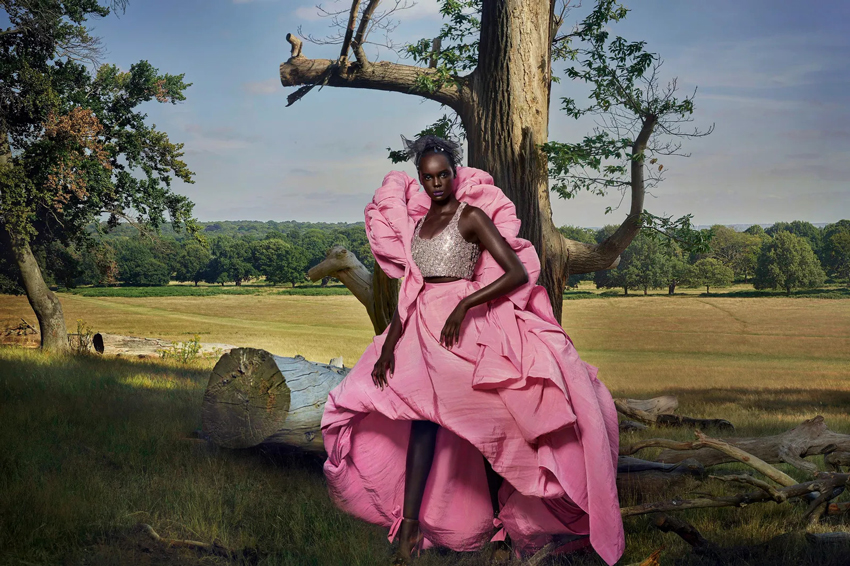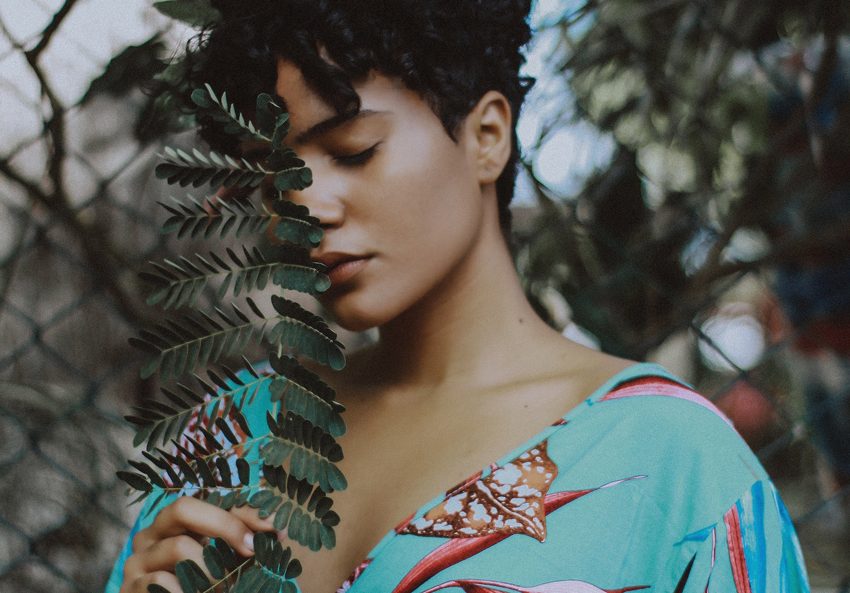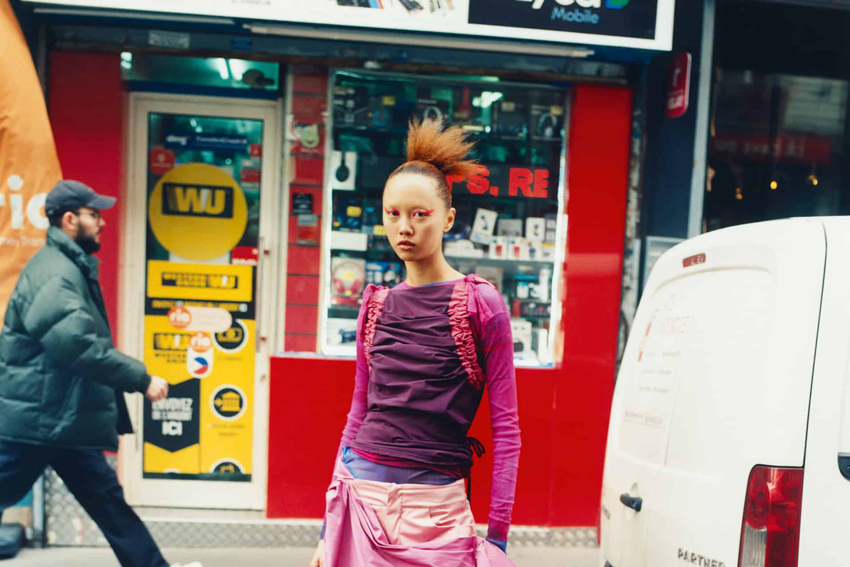The Ultimate Guide to Creative Fashion Photography
Updated on
Fashion photography is more than just capturing clothes - it's about telling a story, evoking emotion, and showcasing style in a visually striking way. Whether you're shooting for a high-fashion magazine or experimenting with your own creative concepts, mastering the art of creative fashion photography is essential to standing out. It's all about thinking outside the box—using lighting, angles, and props to craft unique images that spark conversation. In this guide, we'll explore the essential techniques and strategies to help you shoot fashion photographs that are not only visually captivating but also deeply artistic. Get ready to elevate your fashion photography game and capture moments that are as unforgettable as the trends they highlight.
Part 1: What is Fashion Photography
Fashion photography is a genre of photography focused on capturing clothing, accessories, and styles in a visually striking and artistic manner. Its primary goal is to showcase fashion in a way that highlights not only the garments but also the mood, aesthetic, and lifestyle associated with the style. Fashion photography is widely used in magazines, advertisements, online retail, and social media to present the latest trends and inspire consumers.
While it is rooted in the fashion industry, fashion photography goes beyond simply documenting clothes. It is a creative discipline that combines elements of art, styling, lighting, and storytelling. Fashion photographers work with models, designers, makeup artists, stylists, and other creatives to craft images that evoke emotion, convey concepts, and often reflect a particular lifestyle or cultural moment.
Types of Fashion Photography
There are different types of fashion photography, each with its own approach:
- Editorial Fashion Photography: Often seen in magazines, this style involves storytelling through images, typically focusing on clothing within a specific theme or concept.
- Commercial Fashion Photography: Focuses on showcasing products, often used in catalogs or online stores. The goal here is to highlight the clothing or accessories clearly and appealingly.
- High-Fashion Photography: A more dramatic and artistic style, often seen in high-end fashion campaigns or runway shows. It involves more creative compositions, lighting, and poses.
- Street Style Photography: Captures everyday fashion worn by people in real-world environments, often reflecting trends or individual style.
- Beauty and Close-Up Fashion Photography: Focuses on capturing makeup, hairstyles, and fashion accessories, sometimes with a stronger emphasis on beauty than the clothing itself.
Fashion photography plays a crucial role in setting trends, influencing public perceptions of beauty, and promoting designers and brands. It often requires a keen understanding of both photography techniques and fashion trends to create compelling, marketable images.

What Makes a Good Fashion Photography
A good fashion photograph goes beyond showcasing clothing—it tells a story, evokes emotion, and presents a clear concept. Here are the key elements that make a great fashion shot:
- Strong Concept and Storytelling: A clear, engaging concept ties together the model, styling, and setting, creating a narrative that resonates with the viewer.
- Lighting: Effective lighting enhances textures, shapes, and moods. Whether soft or dramatic, the right light can transform the atmosphere of the shoot and highlight the clothing's details.
- Composition and Framing: Balanced composition guides the viewer's eye and creates visually appealing images. Techniques like the rule of thirds or symmetry ensure the photograph feels intentional and harmonious.
- Model and Pose: A model's expression and pose convey the mood and personality of the shot. The right direction creates energy, elegance, or drama, complementing the clothing.
- Styling and Wardrobe: The clothing, accessories, and styling should align with the concept and contribute to the overall mood, enhancing the fashion story being told.
- Post-Processing: Editing refines the image without overdoing it. Retouching can enhance colors, textures, and lighting, but the essence of the shot should remain intact.
- Attention to Detail: Small details—like fabric texture, light positioning, or the model's subtle movements—add depth and richness to the image.
- Creative Vision: A great fashion photograph reflects the photographer's unique style and creative perspective, often incorporating fresh ideas and bold approaches.
Ultimately, a great fashion photograph combines technical skill with creativity, producing an image that captures attention, inspires, and tells a compelling story.
- Accurate subject separation with transparent details and fine edges in a click
- Produce smooth, gradient-based alpha edges for natural background blending
- Obtain the original quality. Upscale/enhance images to maximize quality with AI
- Provide an AI-powered brush for quick, easy, and flexible manual adjustments
- Bulk processing. Run entirely locally to ensure user data privacy and security

Part 2: How to Prepare for the Perfect Creative Fashion Photography
Preparing for the perfect creative fashion photograph requires a combination of thoughtful planning, a clear vision, and attention to detail. Here's a step-by-step guide to ensure you're fully ready to capture stunning, memorable images:
1. Establish Your Concept
The first step in preparing for a creative fashion photograph is defining the core concept or story behind the shoot. This serves as the foundation for every other decision you make during the process. Consider the mood or emotion you want to evoke—do you want to tell a powerful, dramatic story, or are you leaning towards a light, whimsical vibe? The concept could range from a high-fashion editorial look, with sleek and polished styling, to something more experimental or avant-garde, pushing creative boundaries with unusual elements.
Think about whether your shoot will focus on the clothes, the model's expression, or the setting itself. A minimalist portrait might highlight simplicity and subtlety, while a bold fashion statement could involve extravagant styling and dramatic lighting. Once your concept is clear, it will inform your choices for wardrobe, props, location, and even the type of model you select. A well-defined concept ensures your shoot stays cohesive, visually engaging, and purposeful, allowing you to bring your creative vision to life with precision and confidence.

2. Choose the Right Location
Selecting the right location is a crucial step in bringing your creative fashion photograph to life. The setting should align with the mood and theme you've established for the shoot, acting as a natural extension of the story you're telling. Whether you choose a controlled studio, an industrial space, a natural outdoor scene, or a striking urban backdrop, the location should enhance the overall aesthetic of the shoot.
A studio offers complete control over lighting and environment, making it ideal for high-concept, minimalistic, or controlled setups. If you want to evoke a sense of raw, unfiltered energy, an outdoor or unconventional location—such as an abandoned building, a city street, or a lush forest—can add a unique vibe and texture to your images. Consider the season, the weather, and how the natural elements might play into the overall look.
Before the shoot, it's essential to scout the location to ensure it supports your vision. Pay attention to factors like natural light, potential distractions, and the background's compatibility with your subject. Are there elements that could disrupt the mood you want to create, or is there something in the background that will distract from the fashion? By thoroughly assessing the location ahead of time, you can make necessary adjustments, choose the best angles, and be fully prepared for the shoot.
3. Select the Perfect Model
Choosing the right model is essential to translating your creative vision into a compelling fashion photograph. The model should not only fit the look of your concept but also have the ability to bring depth to the shoot through emotion, body language, and attitude. Whether you're aiming for elegance, energy, or something more experimental, the model's expression and movement can completely transform the mood of the image.
Look for someone who can communicate the essence of your theme without needing constant direction. Their ability to adapt to different poses and experiment with expressions will make a significant difference in how the photograph feels. For example, a model who excels in fierce, high-fashion poses may be perfect for a more dramatic editorial shoot, while someone with a more laid-back or ethereal vibe might suit a relaxed, bohemian aesthetic.
It's also important to establish clear communication before the shoot. Discuss your concept, the desired mood, and specific poses or movements you want to experiment with. This ensures you're both on the same page and helps the model feel more confident and comfortable during the shoot. A collaborative approach will help you achieve a seamless flow during the session, allowing the model to naturally embody the story you're trying to tell through your photographs.

4. Styling and Wardrobe
The wardrobe is one of the most important elements in creative fashion photography, as it directly reflects the concept and mood you want to convey. Choose outfits that align with your vision, paying close attention to color palettes, textures, and fabrics. The clothing should not only complement the model but also enhance the overall narrative you're trying to tell. For example, a sleek, tailored suit can add sophistication to a high-fashion shoot, while flowing, bohemian dresses might suit a more relaxed, natural vibe.
Accessories such as jewelry, shoes, and hats can play a vital role in adding depth to the look. They should be selected thoughtfully to either complement or contrast with the main outfit, creating visual interest without overwhelming the clothing. A statement necklace or a bold pair of heels, for instance, can elevate a simple outfit, adding a layer of personality to the photograph.

If possible, collaborate with a stylist who understands your concept and can help ensure that every detail is on point. A stylist will have the expertise to pull together a cohesive look, considering not only the garments but also the mood and energy of the shoot. The goal is to keep the fashion as the focal point while subtly incorporating details that enhance the overall aesthetic, resulting in images that are both striking and intentional.
5. Lighting Setup
Lighting is one of the most powerful tools in creative fashion photography, as it sets the mood, enhances textures, and highlights the model and clothing. The right lighting can transform a simple shoot into something extraordinary, making it crucial to choose the right lighting setup based on the atmosphere you want to create.
Natural light, with its soft and flattering qualities, can add warmth and a sense of authenticity to your images. It's ideal for outdoor shoots or studio sessions where you want to capture a more organic, natural feel. The key is to use it wisely—whether it's soft, diffused light for a gentle glow or harsher light for dramatic shadows, the time of day and weather conditions will impact the final result. Golden hour, just before sunset or after sunrise, is particularly sought after for its rich, warm tones and long shadows.
On the other hand, artificial lighting offers more control and flexibility. Using light sources like softboxes, umbrellas, and reflectors, you can sculpt the lighting to create moodier, more dramatic effects. Key lights, fill lights, and backlights can all be combined to achieve various contrasts and depth in your image. A strong, direct light can add sharp shadows for a high-fashion, edgy look, while soft, diffused lighting can create a dreamy, romantic vibe.
Experimenting with different setups is crucial. You may want to play with the placement of your light source, adjusting its distance and angle to see how it affects the model and scene. Combining different types of lights—such as using a main light and a secondary fill light—can allow you to control the exposure, reduce harsh shadows, and balance the overall look.
By understanding and experimenting with both natural and artificial lighting, you can create a wide range of effects, from soft, glowing portraits to bold, cinematic shots. The right lighting choice will elevate your fashion photography, ensuring your images match the mood and message you wish to convey.
Related Search: How to Take a Photo without Shadow >>
6. Incorporate Props and Accessories
Props and accessories can significantly enhance a fashion photograph by adding depth and personality, but they should always support, not overshadow, the clothing and model. When choosing props, ensure they align with your concept and theme. For example, a vintage chair might complement a classic look, while geometric shapes could suit a modern style. Accessories like hats, bags, or jewelry can emphasize the clothing's style and elevate the overall aesthetic.
Props can also add subtle layers to your shot. A flowing piece of fabric or a piece of furniture can create movement or visual interest, guiding the viewer's eye without drawing attention away from the fashion. The key is balance—ensure props enhance the scene without competing with the outfit.

Thoughtfully chosen props and accessories will add richness to your fashion photographs, helping to tell a more compelling story while keeping the focus on the clothing and the model.
7. Plan Your Shots and Camera Settings
Effective planning is crucial for capturing the perfect fashion photograph. By creating a detailed shot list and thoughtfully considering your camera settings, you can ensure the shoot runs smoothly and that you capture the images exactly as envisioned. Here's how to plan your shots and fine-tune your camera settings for the best results.
Shot Planning
Begin by creating a shot list that outlines the types of shots you want to capture. Think about a variety of angles and compositions to add visual interest and ensure you have a range of images to work with. For example:
- Wide-Angle Shots: Use these to capture the full outfit and the overall environment, providing context to the scene and highlighting the setting.
- Medium Shots: Focus on the model from the waist up, allowing you to show details of the clothing while still maintaining a sense of the surroundings.
- Close-Ups: Use these to emphasize specific details like fabric texture, accessories, or intricate design elements, drawing attention to the finer aspects of the fashion.
Varying your compositions will make the photo set more dynamic and engaging. Don't be afraid to experiment with different framing techniques like the rule of thirds, leading lines, or even asymmetrical compositions. Each shot type serves a purpose, from full-body shots that capture the complete look, to tighter frames that tell a more intimate story about the garments or accessories. Always be prepared to deviate from the plan to experiment with spontaneous, creative moments.
Camera Settings
Now that you have your shots planned out, it's time to adjust your camera settings to ensure you get the best possible results. Camera settings should be tailored to the specific conditions and style of the shoot. Here's a more detailed guide to optimize your settings:
- Aperture (f-stop): The aperture controls the depth of field in your shot. A wide aperture (e.g., f/2.8 to f/5.6) is often used in fashion photography to create a shallow depth of field, which blurs the background and isolates the model or clothing. This technique helps the subject stand out sharply against a softer, less distracting background. If you want more of the scene in focus, especially for wide shots where you want both the model and the environment to be in focus, you'll need to use a smaller aperture (e.g., f/8 to f/11).
- Shutter Speed: Shutter speed determines how motion is captured in the image. For a sharp, crisp fashion photograph, a shutter speed of 1/125s or faster is typically sufficient to freeze the action, especially if your model is posing or moving. If you're shooting in low light or want to capture movement, you may need to reduce the shutter speed. However, be careful with slow shutter speeds, as they can introduce motion blur unless intentional (e.g., for capturing dynamic poses or flowing fabrics). A 1/60s or slower shutter speed is ideal for more dramatic effects like movement but requires steady hands or a tripod.
- ISO: ISO controls the camera's sensitivity to light. In ideal lighting conditions, keep the ISO as low as possible (ISO 100 to 400) to avoid introducing noise or grain into your images. However, in dimmer environments or when you need faster shutter speeds (to freeze motion), you may need to increase the ISO. In these situations, ISO 800 to 1600 is typically acceptable, but be aware that higher ISO settings can lead to noticeable grain. When shooting in challenging lighting conditions, always test the ISO settings and adjust to find the right balance between exposure and image quality.
- White Balance: White balance ensures that the colors in your photograph are accurate and natural, compensating for the color temperature of the light source. If you're shooting in a studio with controlled lighting, setting your white balance to daylight or tungsten (depending on your light) will often give you accurate color results. For mixed lighting (like a combination of natural light and artificial light), you may need to adjust the white balance manually to prevent color casts, such as yellow or blue tones. Shooting in RAW format allows more flexibility in post-production to fine-tune white balance without losing detail.

Additional Tips
- Focus Mode: For fashion shoots, it's often best to use single-point autofocus to ensure your subject (usually the model's face or key features like accessories) is sharp. If your model is moving or if you want to experiment with dynamic shots, you might switch to continuous autofocus to keep the subject in focus as they change positions.
- Lens Choice: The lens you use has a huge impact on the mood of your fashion shots. For full-body shots, a 50mm to 85mm lens is ideal, providing a flattering perspective without distortion. For close-ups or detailed shots, a 100mm macro lens will allow you to focus on the finer details of fabric, accessories, or jewelry.
By thoroughly planning your shots and carefully adjusting your camera settings, you'll be well-equipped to capture stunning fashion photographs. This preparation ensures you're able to adapt to different conditions and creative opportunities during the shoot, allowing you to focus on delivering the artistic results you envisioned.
8. Coordinate with Your Crew
Effective communication with your team is crucial. Brief your photographer, stylist, makeup artist, and any other crew members on the concept, mood, and specific requirements for the shoot. Make sure everyone understands their role in bringing the vision to life.

